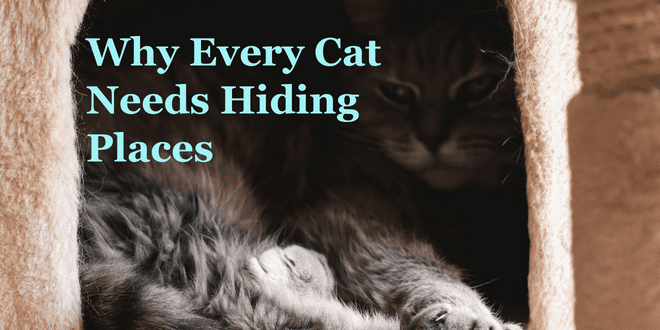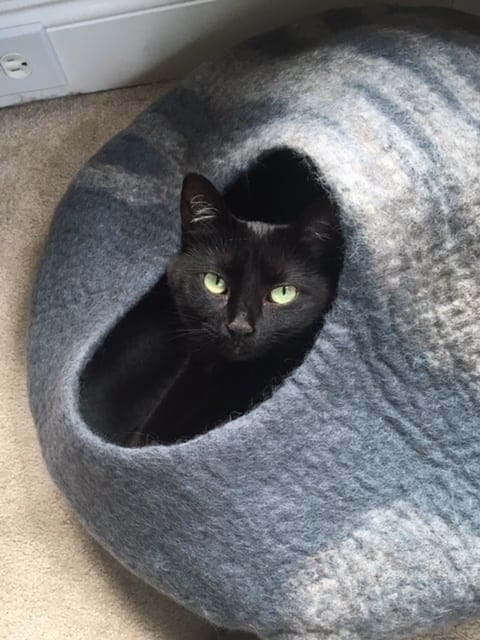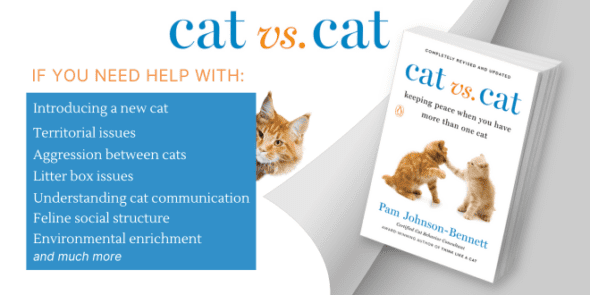
Since the early 1980s when I first started working with clients on their cats’ behavior problems, a big part of my consultations covered the importance of creating an environment that allows the cat to engage in natural behaviors, provides security and strengthens the cat/human bond. The umbrella term for these things is commonly referred to as environmental enrichment.
One aspect of environmental enrichment that’s often misunderstood or overlooked is the need for the cat to have hiding places. When many people think of a cat hiding, they think of it as always being a negative. A cat who’s frightened will almost always look for a safe place to seek refuge and it’s important to do behavior work to help the cat feel more secure, but it’s also crucial that hiding places be made available. If a cat doesn’t have a place to hide then he’ll remain stressed and frightened. Hiding places give the cat time to calm down and it’s then he can start to make the choice about when and how to venture out again. If the cat doesn’t have a place to hide, he’ll be less likely to feel relaxed enough to engage. The cat who feels backed in a corner without any choices is the cat who lashes out or bites. When given the choice, a fearful cat will almost always seek to run and hide. An important part of the behavior process with a frightened cat involves offering those hiding places.
Even if your cat isn’t normally fearful, it’s still important there are adequate hiding places available in your home. If you have a multiple cat household the availability of hiding places in all the different territories within the home is essential. There are times when a cat wants to be visible and there are times when he prefers to be invisible. Solo cats, companion cats, confident ones, and less confident ones will all appreciate the availability of secure hiding places. For some cats the hiding places may just be cozy napping areas out of reach of the family dog but for other kitties those hiding places may be viewed as sanctuaries from fear.

Photo: Pam Johnson-Bennett
When we think of environmental enrichment, the first things that probably come to mind are toys, climbing structures, and opportunities for entertainment. Those things, while extremely important, are only pieces of the overall puzzle. Enrichment involves allowing the cat to engage in normal behaviors and for an animal who has the unique distinction of being both predator and prey, the ability to hide ranks right up there on the list.
Cozy Hideaways for Cats
Hiding places can be created with things you already have around the house. Your cat may use hiding places for different reasons so that should determine the type of set-up you create. For example, a hiding place created as a napping area should be comfy and cozy. An “A” frame bed, cave style, or donut bed work well there. If you want to create a homemade option, you can take a box, turn it on its side and line it with a comfy towel. Pay attention to whether your cat prefers to nap in an elevated location or on a mid-level and that will help you in terms of where to place the cozy napping hideaway. My cat, Pearl, loves her hideaway during the winter months when the house is a bit on the cooler side. The more enclosed bed helps her own body heat keep her warm.
If your cat loves to be on a cat tree but doesn’t like to be so exposed, you can attach a hideaway to the top perch or buy a tree that has a hiding place built in to one of the perches.
Typically, cats don’t feel as secure on ground level so some napping hideaways should be elevated to some degree. Depending upon your cat’s personality and the circumstances within your environment, that elevation can be simply mid-level or it may have to be high enough to be out of reach of children or the family dog.
Sometimes Cats want the Option of Invisible Travel
If your cat is hesitant to walk around the room or you have a multiple cat household where there’s some tension between the cats, it can be helpful to offer ways for the less confident cats to navigate less conspicuously. I use this method with new cats in their sanctuary rooms. The cat may be hiding in the closet or under the bed because he’s afraid to travel to the food bowl or litter box. Being so exposed makes the cat vulnerable. I set up tunnels as safe routes to resources so the cat can feel hidden. I make tunnels out of paper bags by cutting the bottoms of the bags, opening the bags up and taping them together. You can also make tunnels out of long boxes. The homemade tunnels allow you customize the length easily and also to add peek holes in the tunnels so the cat can look out and begin to get to know the new environment.
This hiding tunnel method can also be used in a multicat home to help a cat walk through a room. You can place the tunnels next to furniture so the less confident cat can quietly walk through the room. When creating a tunnel for a multicat environment, cut an escape hole halfway through so there’s always an option for one cat to make a quick exit if halfway through the tunnel another cat enters.
Let Your Cat Choose Hiding Instead of Running
If you have a fearful cat who always dives under the bed when company comes to the house, set up an elevated hideaway option in the living room so kitty will have a safe choice for remaining with you instead of going off alone. It may create an opportunity for the cat to start to feel more secure around people.
Always Offer Choice to Your Cat
A huge part of my behavior technique has to do with making sure the cat always has a choice. A cat who doesn’t have choices is the cat who feels stressed and backed in a corner. The cat who has the choice whether to be seen or remain hidden, whether to sit on the cat perch or on the arm of the sofa, or whether to engage or just observe, is the cat who will feel less anxious. Offering a hiding place or two is just one aspect of creating a secure, comfortable and safe environment for a cat, but for a fearful cat, it can make a huge difference.
Need more Information?
For more information cat behavior and training, refer to the books by best-selling author Pam Johnson-Bennett. Pam’s books are available at bookstores and online. We’ve included links to Amazon here on our website.
If you have a question regarding your cat’s health, please contact your veterinarian. This article is not intended as a replacement for your cat’s veterinary care.


